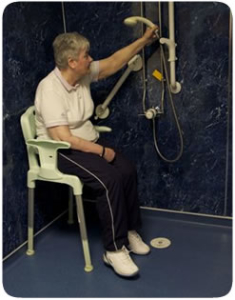Anyone who has a physical disability will usually find that the bathroom can potentially be more hazardous after the medical issue occurs. Someone who has, for example, had a stroke, may find it harder to move around safely on slippery, wet surfaces. A fall onto hard tile could cause further medical problems, as well. At least at first, the stroke survivor may need some help in the bathroom to complete some tasks.
Fortunately, there are many approaches and stroke supplies available that can help you to modify the bathroom so the stroke patient can do what she needs to do easily and safely at the bathtub, sink or toilet.
An occupational therapist can help the patient with training in personal care strategies that make it safer and easier for the patient in the bathroom.
Simple bathroom adaptions make it much easier in the bathroom for the stroke patient
The Importance of Balance and Stability
When the patient is getting into the shower or bathtub, the use of a walker or a can can be added to by using grab bars that are bolted to the walls. Grab bars are very useful when the person is getting into or out of the tub. A person who has strong upper body strength should be able to grab the bars when they are moving or standing so they have more support. Also, having a no skid bathmat can be very helpful outside the shower so the person is going to feel more stable.
Another good idea is to have a transfer tub bench that is in the tub but extends outside of it to the side. It is used for sitting and sliding into the tub, without having to actually step into the tub. The stroke patient only needs to lift her legs over the side to enter the tub. This type of product often is used with a hand held shower, because the person is seated as she showers.
Another great modification for the tub or shower is a shower chair (see Shower Chair With Arm Rests), which usually will feature rubber tips on each leg so it will not slide.
Tips for Toilet Use
Balance and stability come into play when using the toilet, just as when using the tub or shower. By installing handrails or grab bars, the stroke patient will have an easier time getting stabilized as she gets up or down.
Also, a raised toilet seat, such as the Millennia Raised Toilet Seat With Arms, will help the stroke patient to sit or stand up more easily. Or, consider the UpLift Commode Assist. This is a self powered, lifting commode that will help the stroke patient to get up and down easily from the toilet. It can be used by itself or over your toilet. It will lock automatically into the proper position when it is fully depressed.
By doing a few simple modifications to the bathroom, with some convenient stroke aid supplies, the stroke patient will be able to easily handle all of her bathroom needs independently and safely.




